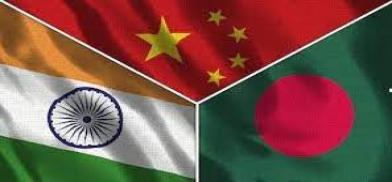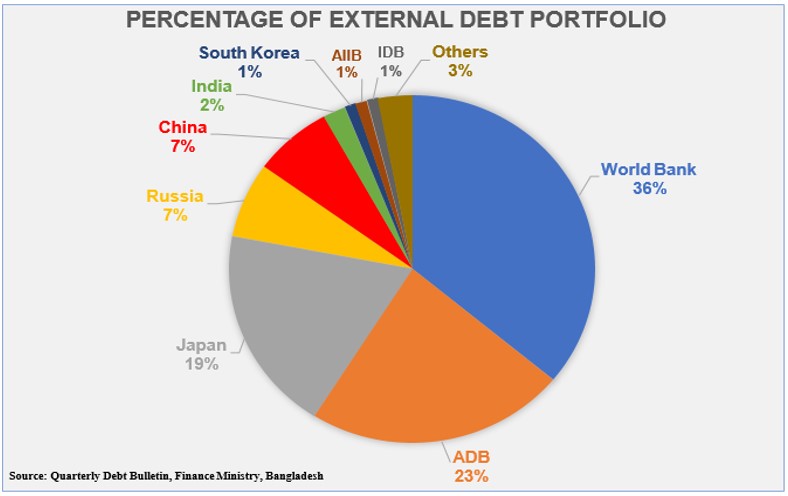China poses no threat to the multi-faceted India-Bangladesh partnership
The accompanying data and graphs indicate that random charges about Bangladesh tilting toward China are just hype and with no basis in facts. Unlike Pakistan and Sri Lanka, Bangladesh has conducted prudent macroeconomic management in order to avoid overdependence on China.

Bangladesh and India have a unique relationship not only due to their geographical proximity but also because of their similar socioeconomic background, shared history, and common culture. The Liberation War in 1971 also resulted in the formation of a blood connection between the two countries. Since then, both countries have maintained a stable and productive diplomatic relationship in the areas of politics, culture, trade, and business.
Bangladesh plays a significant role in India's Neighborhood First policy. Delhi under Narendra Modi has always supported Bangladesh, whether it was prioritizing COVID vaccination delivery or arranging an evacuation of Bangladeshis trapped in the Russia-Ukraine war. Similarly, Bangladesh, under the leadership of Sheikh Hasina, has won Indian hearts by addressing all of their concerns, from connectivity to security.
Indian nationals have expressed confidence in Hasina's management of terrorist operations in Bangladesh. The post-2009 crackdown on anti-India separatists in the Northeast by the Hasina government has been the single most important factor that has led to a huge drop in the insurgency in that region—an 80 percent drop in rebel violence, according to the latest report of the Indian Home Ministry. Hasina succeeded in apprehending the cross-border anti-India insurgency groups and turning them over to Indian authorities.
Ties
However, after coming to a settlement on matters relating to maritime delimitation, land border arrangements, enclaves, sea shipping, and inland waterways, both nations are now at a favorable point in their diplomatic ties. Since the Sheikh Hasina government came to power in 2009, trade ties with India have greatly improved, with Bangladesh now India's largest trading partner in South Asia. In 2021–22, the total trade between India and Bangladesh was worth $16.38 billion, with India exporting goods worth $14.58 billion and importing goods worth $1.8 billion.
In an advancement of bilateral relations, Bangladesh and India signed a Framework Agreement on Cooperation for Development, under which both parties agreed to narrow trade imbalances and expand their cooperation to the sub-regional level. Both countries are now working towards signing a Comprehensive Economic Partnership Agreement (CEPA), which emphasizes three specific dimensions: trade in goods, services, and investments.
Both governments have recently undertaken initiatives to boost connectivity. Multi-modal transit between the Indian mainland and the country’s northeast is increasingly becoming a reality with the development of ‘connectivity infrastructure’ by Bangladesh. Indian businessmen invested in Bangladesh’s garment industry are looking to expand their manufacturing to Tripura, opening fresh vistas for the industrialization of the Northeast. Agartala, emerging as India’s third internet gateway due to its connection with Bangladesh’s internet backbone, now offers a huge opportunity for the growth of the IT industry in the Northeast.
Relations a role model
In the past eight years, India has extended credit lines worth $8 billion to Bangladesh for developmental projects in sectors including roadways, shipping, ports, and railways. This makes Bangladesh the recipient of India’s largest concessional credit lines to a single country. India's projects in Bangladesh include an upgrade of the Ashuganj river port and the Akhaura land port road, with a credit line of more than $400 million. A road project connecting the India-Bangladesh border is also being worked upon, with a further line of credit worth $80 million from India.
However, it is not only the trade and economic aspects that make the relations between the two countries a role model for the world, but rather their mutual trust, respect, and win-win cooperation. Indian Prime Minister Narendra Modi has always had positive relations with Bangladesh as a result of the goodwill gestures made by PM Sheikh Hasina. Modi, in one of his first foreign visits after the COVID-19 outbreak, visited Bangladesh to participate in its Golden Jubilee of its independence.
In spite of an intense level of engagement between the two governments, some quarters in India criticise Bangladesh, terming it a "China-tilting" country, without backing it up with specific data or logical analysis. There is a misperception among many people that Bangladesh could fall into the Chinese debt trap. Bangladesh has decades of experience managing aid and loans, working with a variety of bilateral and multilateral funders. Bangladesh has received most of its loans from international agencies, with Japan being the largest bilateral lender (19 per cent).

Clearly, Bangladesh’s external loan portfolio is dominated by the World Bank, which accounts for 36 per cent of total external loans, and the Asian Development Bank, which accounts for 23 per cent. Of the $72.3 billion foreign loan, the World Bank accounts for $18.2 billion, followed by the Asian Development Bank ($13.3 billion), Japan ($9.2 billion), Russia ($5.1 billion), China ($4.8 billion), and India ($1.02 billion). The data clearly shows that Bangladesh's loan from China is a trifling amount compared with the country's GDP of $416 billion. Bangladesh has a low risk of external and overall debt distress despite higher external borrowing in recent terms, said the International Monetary Fund in February.
Bangladesh’s relations with China are primarily based on trade and commerce. Chinese projects in Bangladesh are mainly in infrastructure building, energy and power sector, transportation networks, and municipal services. Bangladesh is aware of geopolitical sensitivities and takes on only those Chinese projects that have economic viability. It has cancelled several China-proposed projects due to their lack of commercial feasibility. For example, Bangladesh did not allow a 14 billion USD Chinese investment in the Sonadia deep sea port as Japan's proposed Matarbari was more viable. Two railway projects worth a total of 3.5 billion USD were also scrapped by Bangladesh due to their lower financial viability.
Reports claimed that, over the past decades, Bangladesh has received $2.6 billion in FDI from China. However, in recent months, the inflow of Chinese foreign direct investment (FDI) in Bangladesh has been low compared to other major development partners. China is the 5th largest source of FDI behind the USA, UK, Singapore, and South Korea in FY 2022–23.

The accompanying data and graphs indicate that random charges about Bangladesh tilting toward China are just hype and with no basis in facts. Unlike Pakistan and Sri Lanka, Bangladesh has conducted prudent macroeconomic management in order to avoid overdependence on China. So, even an economic downslide due to the COVID-19 pandemic and the Russia-Ukraine war has not been able to drive Dhaka into China’s sphere of influence.
On the other hand, the steady growth of the India-Bangladesh bilateral partnership proves that India-Bangladesh ties being a role model of good neighborhood diplomacy is not a shallow statement made by Sheikh Hasina to present a certain idea of the bilateral relationship. It is rather a strong testimony to the power of cooperation that can lead to mutually beneficial relations while also elevating their economic, social, and political statuses in the global forum.
(The author is a New Delhi-based researcher and political analyst. Views are personal. He can be contacted at pschaturvedi.sau@gmail.com )














Post a Comment